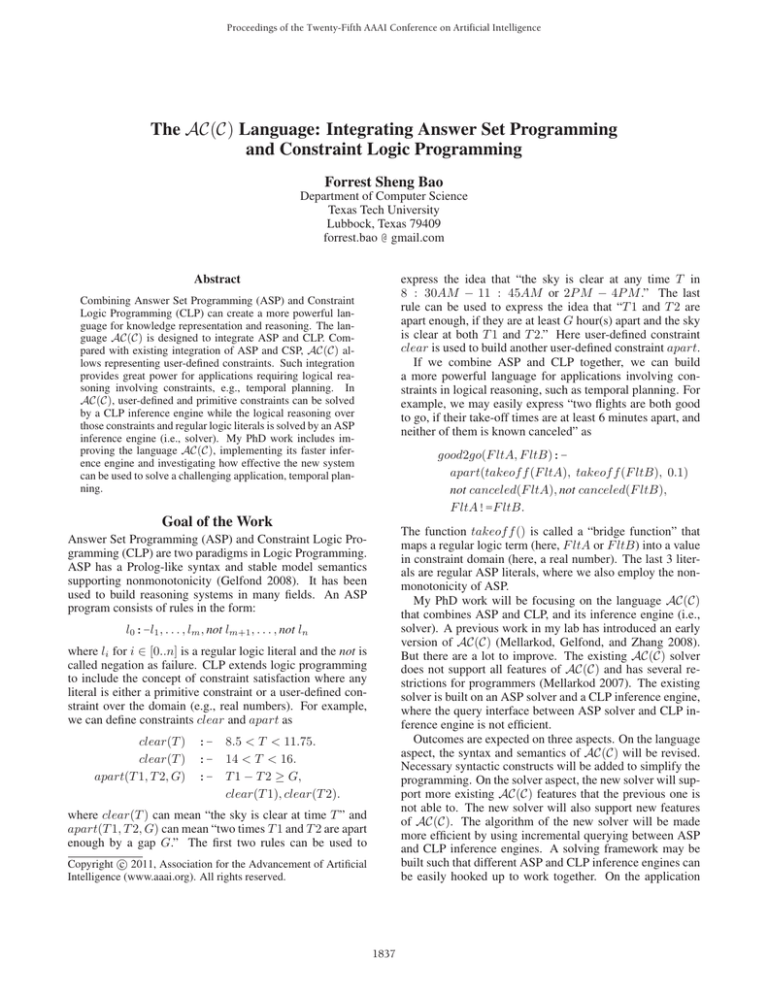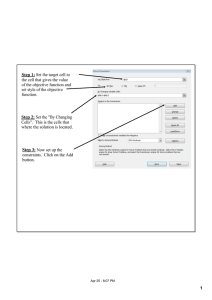
Proceedings of the Twenty-Fifth AAAI Conference on Artificial Intelligence
The AC(C) Language: Integrating Answer Set Programming
and Constraint Logic Programming
Forrest Sheng Bao
Department of Computer Science
Texas Tech University
Lubbock, Texas 79409
forrest.bao @ gmail.com
express the idea that “the sky is clear at any time T in
8 : 30AM − 11 : 45AM or 2P M − 4P M .” The last
rule can be used to express the idea that “T 1 and T 2 are
apart enough, if they are at least G hour(s) apart and the sky
is clear at both T 1 and T 2.” Here user-defined constraint
clear is used to build another user-defined constraint apart.
If we combine ASP and CLP together, we can build
a more powerful language for applications involving constraints in logical reasoning, such as temporal planning. For
example, we may easily express “two flights are both good
to go, if their take-off times are at least 6 minutes apart, and
neither of them is known canceled” as
Abstract
Combining Answer Set Programming (ASP) and Constraint
Logic Programming (CLP) can create a more powerful language for knowledge representation and reasoning. The language AC(C) is designed to integrate ASP and CLP. Compared with existing integration of ASP and CSP, AC(C) allows representing user-defined constraints. Such integration
provides great power for applications requiring logical reasoning involving constraints, e.g., temporal planning. In
AC(C), user-defined and primitive constraints can be solved
by a CLP inference engine while the logical reasoning over
those constraints and regular logic literals is solved by an ASP
inference engine (i.e., solver). My PhD work includes improving the language AC(C), implementing its faster inference engine and investigating how effective the new system
can be used to solve a challenging application, temporal planning.
good2go(F ltA, F ltB):apart(takeof f (F ltA), takeof f (F ltB), 0.1)
not canceled(F ltA), not canceled(F ltB),
F ltA!=F ltB.
Goal of the Work
The function takeof f () is called a “bridge function” that
maps a regular logic term (here, F ltA or F ltB) into a value
in constraint domain (here, a real number). The last 3 literals are regular ASP literals, where we also employ the nonmonotonicity of ASP.
My PhD work will be focusing on the language AC(C)
that combines ASP and CLP, and its inference engine (i.e.,
solver). A previous work in my lab has introduced an early
version of AC(C) (Mellarkod, Gelfond, and Zhang 2008).
But there are a lot to improve. The existing AC(C) solver
does not support all features of AC(C) and has several restrictions for programmers (Mellarkod 2007). The existing
solver is built on an ASP solver and a CLP inference engine,
where the query interface between ASP solver and CLP inference engine is not efficient.
Outcomes are expected on three aspects. On the language
aspect, the syntax and semantics of AC(C) will be revised.
Necessary syntactic constructs will be added to simplify the
programming. On the solver aspect, the new solver will support more existing AC(C) features that the previous one is
not able to. The new solver will also support new features
of AC(C). The algorithm of the new solver will be made
more efficient by using incremental querying between ASP
and CLP inference engines. A solving framework may be
built such that different ASP and CLP inference engines can
be easily hooked up to work together. On the application
Answer Set Programming (ASP) and Constraint Logic Programming (CLP) are two paradigms in Logic Programming.
ASP has a Prolog-like syntax and stable model semantics
supporting nonmonotonicity (Gelfond 2008). It has been
used to build reasoning systems in many fields. An ASP
program consists of rules in the form:
l0 :-l1 , . . . , lm , not lm+1 , . . . , not ln
where li for i ∈ [0..n] is a regular logic literal and the not is
called negation as failure. CLP extends logic programming
to include the concept of constraint satisfaction where any
literal is either a primitive constraint or a user-defined constraint over the domain (e.g., real numbers). For example,
we can define constraints clear and apart as
clear(T )
clear(T )
apart(T 1, T 2, G)
:- 8.5 < T < 11.75.
:- 14 < T < 16.
:- T 1 − T 2 ≥ G,
clear(T 1), clear(T 2).
where clear(T ) can mean “the sky is clear at time T ” and
apart(T 1, T 2, G) can mean “two times T 1 and T 2 are apart
enough by a gap G.” The first two rules can be used to
c 2011, Association for the Advancement of Artificial
Copyright Intelligence (www.aaai.org). All rights reserved.
1837
aspect, AC(C) will be used to represent and solve temporal planning problems, which may be hard to solve in other
tools. The methodology of using AC(C) to model problems
will also be examined in this process.
ing problems that have great drawbacks to be solved in other
tools. In this process, I can also test the modeling ability and
expressiveness of the new AC(C). A good test bed is temporal planning. The language PDDL is a standard in the
planning community to define planning problems. Temporal planning problems have been supported since PDDL2.1.
Existing planners (Huang, Chen, and Zhang 2010; Hu 2007;
Coles et al. 2008) for temporal planning problems have several drawbacks, as analyzed in (Bao et al. 2010). Many planners translate a PDDL2.1 program into a programming problem, e.g., CSP (Hu 2007) and SAT (Huang, Chen, and Zhang
2010), and use the solver for the programming problem as
the planner. Following this idea, I will translate PDDL2.1
into the language AC(C) and then use AC(C) solver to find
the plan. The preliminary translation from PDDL2.1 to
AC(C) has been proposed and this approach is hopefully
to solve the drawbacks of existing approaches (Bao et al.
2010). An automated PDDL2.1-to-AC(C) translator and an
AC(C) solver can form an AC(C)-based temporal planner.
Plan for Research
The first step is to revise the AC(C) language. Through
a work converting PDDL2.1-described temporal planning
problems into AC(C)-representation (Bao et al. 2010), I
have had a better understanding to the design of the language
and the methodology of modeling problems in AC(C). The
understanding will be reflected in the revision to AC(C).
As mentioned earlier, syntactic constructs will be added to
make programming easier. When revising the language, I
want to hear the comments from declarative programming
users. The grammar used to write AC(C) programs for
AC(C) solver to solve, will be released as well. It will
be designed as “user-friendly” as possible to lower the entry level for programmers without much logic programming
background.
Understanding existing AC(C) solver will be the next
step. As a rule of thumb, knowing how previous systems
are built can help build a better system. Besides, the current solver cannot support many features of AC(C). For
example, negations (classical or default) are not allowed in
front of atoms that are not regular ASP ones. When translating PDDL2.1 into AC(C), we have noticed many inconveniences due to the solver. Furthermore, I will identify bottlenecks in the existing solver.
Then, I will start building a new AC(C) solver from
“hacking” the existing solver. The new solver will support
more AC(C) features (including those supposed to be supported by the existing AC(C) solver), and will be more efficient. Since we will have a revision of the language AC(C),
the solver will be modified accordingly. To improve solving
efficiency, a new technique, incremental querying, will be
implemented. The ASP solver cannot evaluate a constraint
(primitive or user-defined) literal but can know whether it is
required to be true or false by methods such as unit propagation. Once the ASP solver requires a constraint literal to be
true, it queries the CLP inference engine to check the satisfiability of the literal. Due to backtracking, a constraint literal
may be queried many times in solving one AC(C) program.
If we can implement incremental querying, e.g., only query
new queries, the efficiency of the solver can be greatly improved.
After building a new working solver from existing solver,
I may implement a general framework for building AC(C)
solver from various ASP and CLP inference engines. Current AC(C) solver, is not built on state-of-the-art ASP and
CLP inference engines. To take advantage of the development in ASP and CLP solving techniques, a general framework is need to allow ASP and CLP inference engines, that
are under active development and maintenance, to easily
hook up into an AC(C) solver. For ASP part, I may choose
Clasp which is the fastest ASP/SAT solver so far. For CLP
part, I may choose one from swi-prolog and YAP.
Finally, I will use AC(C) to represent and solve challeng-
Progress so far
We have shown in a published work a preliminary design of
a translation from PDDL2.1 to AC(C) (Bao et al. 2010). The
syntax and semantics of the language AC(C) itself have been
reviewed in studying the translation. We have investigated
new features that should be added into AC(C) and features
that should be supported by the new solver. We also have an
initial design of the incremental algorithms.
References
Bao, F. S.; Chintabathina, S.; Morales, A. R.; Rushton,
N.; Watson, R.; and Zhang, Y. 2010. Temporally Expressive Planner Based on Answer Set Programming with Constraints: Preliminary Design. Logic Programming, Knowledge Representation, and Nonmonotonic Reasoning: Essays
in Honor of Michael Gelfond. Springer. chapter 13.
Coles, A.; Fox, M.; Long, D.; and Smith, A. 2008. Planning
with problems requiring temporal coordination. In Proceedings of the 23rd national conference on Artificial intelligence
(AAAI), volume 2, 892–897.
Gelfond, M. 2008. Answer sets. Handbook of Knowledge
Representation. Elsevier. 285–316.
Hu, Y. 2007. Temporally-expressive planning as constraint satisfaction problems. In Proceedings of 17th International Conference on Automated Planning and Scheduling (ICAPS), 192–199.
Huang, R.; Chen, Y.; and Zhang, W. 2010. A novel transition based encoding scheme for planning as satisfiability.
In Proceedings of the 24th AAAI Conference on Artificial
Intelligence (AAAI), 89–94.
Mellarkod, V. S.; Gelfond, M.; and Zhang, Y. 2008. Integrating answer set programming and constraint logic programming. Annals of Mathematics and Artificial Intelligence.
Mellarkod, V. S. 2007. Integrating ASP and CLP systems:
computing answer sets from partially ground programs. Dissertation, Texas Tech University.
1838







